Telecentric Lenses
Definition: lenses or objectives having the entrance or exit pupil at infinity
German: telezentrische Objektive
Categories: general optics, vision, displays and imaging
How to cite the article; suggest additional literature
Author: Dr. Rüdiger Paschotta
Various types of objectives, as used for optical instruments like telescopes, photographic objectives and laser scanners, are available with telecentric designs. Telecentricity of an objective essentially means having a orthographic perspective like for an observer at infinite distance. That implies that the chief rays are horizontal left and right of the optical system, and the entrance or exit pupil lies at infinity. Telecentricity is achieved by utilizing an appropriately placed optical aperture, e.g. a diaphragm. In some cases, that is not even required due to the already given restrictions to incoming beams.
One distinguishes between telecentricity on the object and image side, or on both sides; those cases are explained in the following section.
In practice, the telecentric condition (e.g. formulated via horizontal chief rays) is never perfectly fulfilled. Telecentric objectives may therefore have an additional specification concerning the telecentric angle, which tells the deviation from perfect telecentricity.
Object-space Telecentric Lenses
A lens or objective can be made telecentric for the object space by inserting a stop (aperture) in the back focal plane, as shown in Figure 1 for a simple configuration with a single lens. (The same principle can easily be applied to an objective consisting of multiple lenses – it also has a back focal plane.) Only some of the rays, shown in blue color, can get through the stop and contribute to the image.
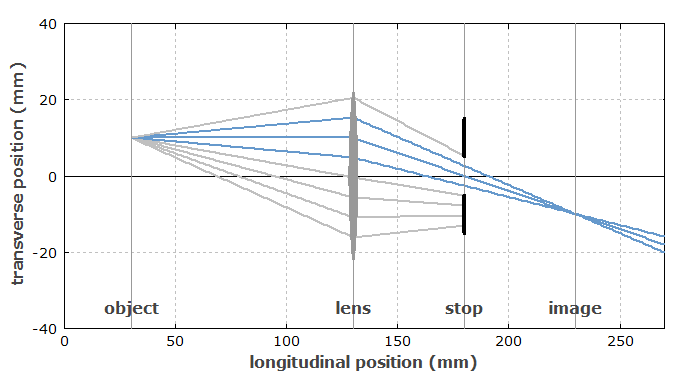
We now consider an image at a closer distance (see Figure 2), which is observed without adjusting the focus. Here, the transmitted rays do no longer meet on the original image plane; if the image sensor stays at the original plane, the image will be somewhat blurred. However, the center of the blurred region stays the same as before. This is because the stop selects only those rays which are approximately horizontal before the lens. Under such conditions, the object position will only affect the sharpness of the image, but not the position; the blurring is symmetrical around the constant center. Note, however, that this works only if the stop is placed in the focal plane of the lens.
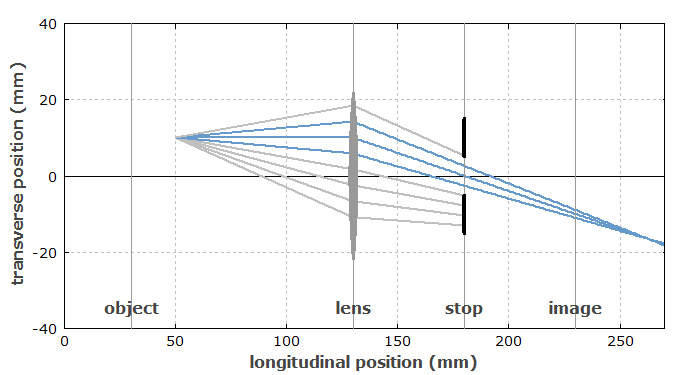
Although the stop could not affect the position of a true focus point as in Figure 1, it can affect the size and center of the blurred region in the defocused situation. The influence of an aperture stop of a photographic objective on the depth of field is explained in the same way.
If we define the magnification via the size on the chosen image plane (independent of the true location of the image plane), the magnification turns out to be independent of the object distance. If the object is moved closer to the lens or further away, one only loses image sharpness, but the apparent size remains unchanged. The blur effect can be reduced (i.e., the depth of field is increased) by reducing the aperture diameter; that would only reduce the image brightness.
Note that the magnification would of course change if the focus adjustment of the objective is modified. One will thus usually not use such a lens with an autofocus device.
The entrance pupil of the objective is obtained by imaging the stop to the left side. As the stop is in the focal plane, the entrance pupil is at infinity. That again underlines the obtained orthographic perspective: it is as for an observer at infinite distance, where changes of the longitudinal object position do not matter.
In contrast, most other (non-telecentric) lenses or objectives (just like human eyes) have their entrance pupil closer to the center of the optical entrance, and thus see objects like from a reference point in that plane (entocentric perspective). The result is that more distant objects are appearing smaller than closer ones. Also, a small near object may fully cover a larger, but more distant object. All that is different for a telecentric system.
The explained operation principle implies some limitations:
- It requires that the image plane has some distance from the stop. Therefore, the device must not be focused to infinity, but to a closer plane. One can therefore not get a large depth of field by using the hyperfocal distance; instead, one must limit the aperture size.
- The field of view – he are not defined as an angular range, but in terms of distances – is at most as large as the entrance diameter of the objective. Therefore, object-space telecentric objectives often have to be made relatively large and are correspondingly heavy and expensive. For the photography of larger objects, telecentric objectives are normally not usable – except with particularly large versions, which can be realized with a Fresnel lens at the input.
An important field of application of object-space telecentric objectives is machine vision, where the orthographic perspective (with low distortion and no parallax error) can greatly simplify the imaging processing. There are also telecentric measurement telescopes, allowing the measurement of true object sizes with no substantial sensitivity to their distance.
Some telecentric lenses contain additional devices for coaxial illumination. Essentially, that means that collimated light is sent through the optics towards the imaged object. In other cases, one uses collimated light coming from the opposite direction, i.e., towards the imaging system, when investigating transparent objects (e.g. for inspection of optical glasses). Note that the camera will then not image the light source; instead, the light source simply leads to homogeneous illumination of the image plane.
With such kinds of directed illumination, which is also sometimes called telecentric illumination, most accurate telecentric imaging is possible, when it comes to precisely capturing edges and surface structures. The exposure time can then be relatively small, since most input light comes in a direction which can be used by the camera.
Note that telecentric illumination does not necessarily require a telecentric lens; a collimated beam is obtained simply by using a rather small light source (e.g. a small light emitting diode) and a collimation lens.
Microscope objectives are also sometimes made object-space telecentric. That avoids the apparent sizes changes of out-of-focus planes in thick specimens. Besides, there are optical profilometers with telecentric optics.
Image-space Telecentric Lenses
Telecentricity can also be implemented in image space by placing an appropriate aperture in the front focal plane. This is shown in Figure 2, again with a simplified setup containing a single lens. Due to the introduced stop, the light rays are essentially horizontal after the lens, if the aperture opening is small.
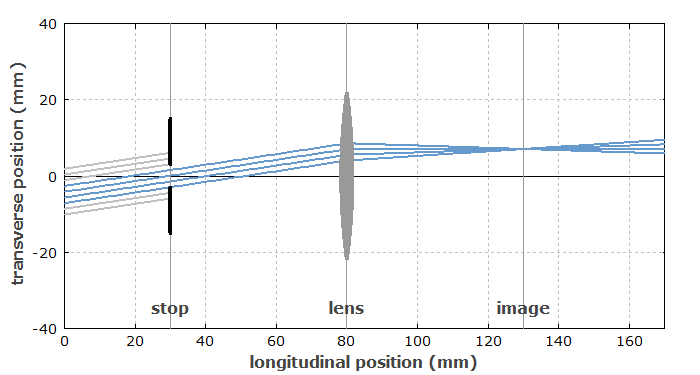
In effect, the vertical position of the image point is independent of the chosen position of an image sensor; it is only that the image point will be somewhat blurred if the sensor is outside the focus. The depth of focus can of course be increased simply by reducing the stop diameter, which however causes a loss of image brightness.
For Figure 2, parallel input rays from a distant object have been assumed, but the configuration would work in the same way for closer objects, only with the focus position somewhat shifted to the right.
For an application, the essential point may not be that the image size is independent of the sensor position, but rather that the light is always reaching the sensor with approximately normal incidence – not only in the center, but also in the peripheral regions. That is important particularly for image sensors containing microlens arrays. Therefore, image-space telecentric objectives are often used in digital cameras.
Another application of telecentric optics are scanning lenses for laser scanners. Telecentric scanning lenses can send a laser beam to different spots on a target surface, but each time with the approximately same direction of propagation. Here, one usually does not have to use a diaphragm; the entrance stop is effectively created by the scanning apparatus, e.g. a polygon mirror wheel or an acousto-optic deflector. Such scanning applications include laser material processing, including special areas like microlithography.
Bi-telecentric Systems
One can also make bi-telecentric systems (or double-telecentric systems), which means telecentricity in both object and image space. That, however, is possible only with afocal optical systems. Figure 3 shows an example. The chief ray (going through the center of the stop) is horizontal left of the first lens and right of the second lens. Note that this can work only if the distance between the lenses is the sum of their focal lengths.
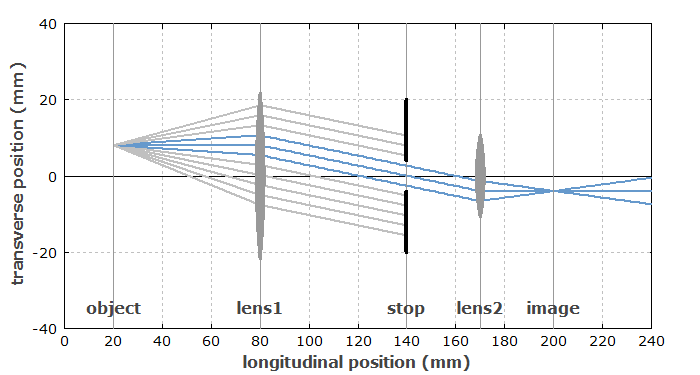
Bi-telecentric imaging systems may be used e.g. where one requires both a orthographic perspective and nearly normal incidence of light on an image sensor.
Telecentric Zoom Lenses
Most telecentric lenses have a fixed focal length and magnification. However, there are also telecentric zoom lenses, where the focal length and thus also the field of view and the magnification is adjustable in some range. In order to maintain telecentricity, the zooming mechanism does not only have to adjust the focal length, but also keep the stop in the focal plane. In some cases, the telecentric condition cannot be maintained over the full zoom range.
Suppliers
The RP Photonics Buyer's Guide contains 16 suppliers for telecentric lenses. Among them:

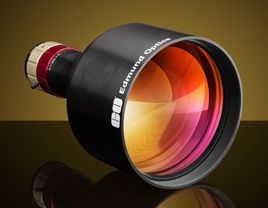
Edmund Optics
Edmund Optics’ telecentric lenses are available with a range of features for a variety of machine vision or inspection applications. TECHSPEC® GoldTL™ telecentric Lenses feature focus adjustment, along with iris adjustment. TECHSPEC® SilverTL™ telecentric measuring lenses includes iris adjustment in addition to a double telecentric design. TECHSPEC® CompactTL™ telecentric lenses feature compact designs ideal for high volume system integration. TECHSPEC® compactTL™ telecentric lenses are available in in-line models. PlatinumTL™ telecentric Lenses are also available to cover large sensor sizes.


Shanghai Optics
Shanghai Optics can quickly and cost effectively provide customers custom high performance telecentric lenses for use in a variety of applications including machine vision, inspection, metrology, image sensor test, projection system, etc.
Questions and Comments from Users
Here you can submit questions and comments. As far as they get accepted by the author, they will appear above this paragraph together with the author’s answer. The author will decide on acceptance based on certain criteria. Essentially, the issue must be of sufficiently broad interest.
Please do not enter personal data here; we would otherwise delete it soon. (See also our privacy declaration.) If you wish to receive personal feedback or consultancy from the author, please contact him e.g. via e-mail.
By submitting the information, you give your consent to the potential publication of your inputs on our website according to our rules. (If you later retract your consent, we will delete those inputs.) As your inputs are first reviewed by the author, they may be published with some delay.
See also: objectives, telescopes, photographic objectives, scanning lenses
and other articles in the categories general optics, vision, displays and imaging
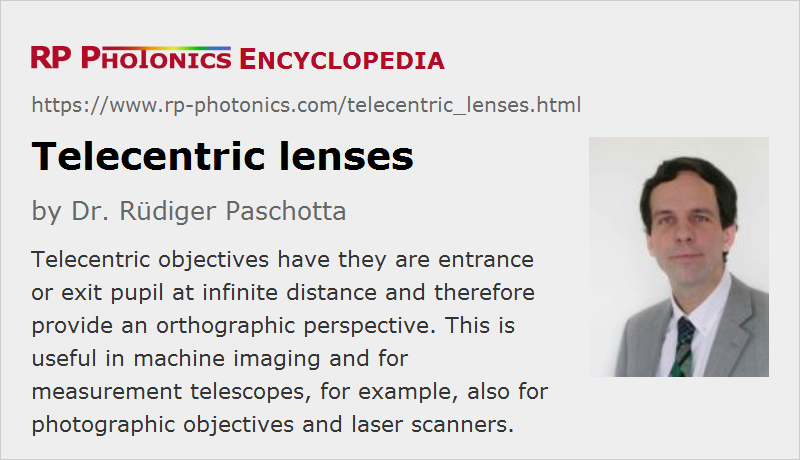 |








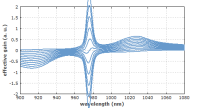
If you like this page, please share the link with your friends and colleagues, e.g. via social media:
These sharing buttons are implemented in a privacy-friendly way!